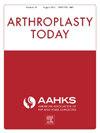Metal-on-Metal Total Hip Arthroplasties: Why Do They Fail?
IF 1.5
Q3 ORTHOPEDICS
引用次数: 0
Abstract
Background
Metal sensitivity reaction is a major concern in painful failed metal-on-metal (MoM) total hip arthroplasty (THA), but it may not be the dominant failure mode. We investigated revised MoM THAs for failure etiologies, operative indications, and clinical outcomes.
Methods
Ninety consecutive revised MoM THAs were reviewed. Preoperative evaluation included inflammatory markers, metal ion levels, radiographs, metal artifact reduction sequence magnetic resonance imaging, synovial fluid analysis, and operative histopathology. Outcome measures included advanced imaging and laboratory findings, revision etiology, and clinical outcomes.
Results
Metal sensitivity reactions (MSRs) accounted for 36% of MoM failures, with 64% of MoM THA being revised for non-MSR-related etiologies. Failure etiologies not related to MoM bearing articulation included prosthetic joint infection (14%), aseptic loosening (13%), isolated abductor failure (7%), periprosthetic fracture (3%), recurrent dislocation (3%), symptomatic heterotopic ossification (3%), mechanical failure (1%), and angiosarcoma (1%). Additionally, 18% of patients had painful MoM THA with no identifiable failure etiology; of these patients, 69% had continued pain following revision. Patients with large periarticular fluid collections had an odds ratio of 19.2 (P =< 0.0001) of having MSR. Cobalt (Co) levels were statistically higher in patients with MSR compared to non-MSR-related failures (P = .034). Chromium (Cr) ion levels and the Co/Cr ratio did not predict MSR.
Conclusions
The majority of revised MoM THAs did not have MSR. Large periarticular fluid collections and elevated Co levels were highly predictive of MSR. Painful MoM THA without an identifiable failure etiology resulted in a high incidence of persistent pain following revision.
求助全文
约1分钟内获得全文
求助全文
来源期刊

Arthroplasty Today
Medicine-Surgery
CiteScore
2.90
自引率
0.00%
发文量
258
审稿时长
40 weeks
期刊介绍:
Arthroplasty Today is a companion journal to the Journal of Arthroplasty. The journal Arthroplasty Today brings together the clinical and scientific foundations for joint replacement of the hip and knee in an open-access, online format. Arthroplasty Today solicits manuscripts of the highest quality from all areas of scientific endeavor that relate to joint replacement or the treatment of its complications, including those dealing with patient outcomes, economic and policy issues, prosthetic design, biomechanics, biomaterials, and biologic response to arthroplasty. The journal focuses on case reports. It is the purpose of Arthroplasty Today to present material to practicing orthopaedic surgeons that will keep them abreast of developments in the field, prove useful in the care of patients, and aid in understanding the scientific foundation of this subspecialty area of joint replacement. The international members of the Editorial Board provide a worldwide perspective for the journal''s area of interest. Their participation ensures that each issue of Arthroplasty Today provides the reader with timely, peer-reviewed articles of the highest quality.
 求助内容:
求助内容: 应助结果提醒方式:
应助结果提醒方式:


